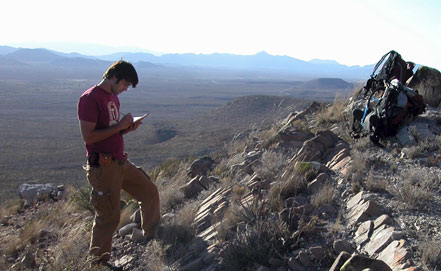


| The Paleohydrology of Salt Structures in Northern Mexico |
In the northeastern corner of Mexico, at the tip of the Sierra Madre Oriental mountain range, towering ashy grey rock formations rise sharply from the earth. It was here, in this section of a fold-and-thrust belt formed during the late Cretaceous period, that Professor Mark Fischer found inspiration for his current project.
He was stunned by his geologically spectacular surroundings, and even more intrigued by the possibilities for research. "I wanted to go back and work in this area because there were a lot of really interesting, challenging and beautiful problems to work on." The number one challenge on his list: the study of paleohydrologic systems, essentially models of how ancient fluids moved around the subsurface of the earth.
In some parts of the world, there are extensive layers of salt, some several thousand feet thick and covering vast areas. The bodies of salt can shift, which Fischer likens to toothpaste being squished around in a tube. Sometimes it rises up to make huge towers or columns, known as diapirs, and in other places it might form large, thin sheets. Of course, salt is not the only substance moving beneath the earth's surface. Various fluids are moving around as well, and because of the impermeability of salt, those fluids (particularly the oil and gas that the oil companies are interested in) get trapped next to or underneath the bodies of salt. The question then, is how to best predict where and to what degree these fluids might accumulate.

Faulted calcite veins. Geochemical and structural analysis of veins like these provide telling information about
ancient fluids that moved through the rocks.
Professor Fischer, along with his small team of graduate students at Northern Illinois University, hopes that their paleohydrologic models can be used to predict modern fluid behavior. The unique feature of this area in the Sierra Madre Oriental is that some of the salt structures are actually exposed at the surface. The team can easily gather samples of the veins within the structures, which contain mineral residue from the fluids that once moved through internal fractures and cracks. Geochemical analysis of these veins helps to reveal clues about the fluids' characteristics, such as where they came from, how hot they were, and how long they sat beneath the subsurface.
Increased knowledge of fluid behavior could mean huge benefits for oil companies, including more efficient extraction methods and decreased monetary risk. According to Fischer, what he's after is to try to understand why the oil and gas is here and not over there, where "here" and "there" might only be separated by ten kilometers. He adds, "It might be the difference between spending a $100 million on a dry well or spending $100 million on a discovery that could be worth billions."

NIU graduate student Adam Smith taking notes and collecting vein samples in the La Popa Basin, Mexico.
The potential practical applications for his findings are an exciting component of the project, not only for Fischer, but also for his students. He likes to involve his undergraduate students as much as possible, in order to keep them inspired. They get excited about it," he says. They like to see how we solve real world problems using all the stuff we're learning from textbooks and lectures on a weekly basis. Students always wonder: What bearing does this have on everything that goes on in the real world?
Read Dr. Fischer's full research findings, The Paleohydrologic System Near a Salt Diapir and Weld in the La Popa Basin, Northeastern Mexico.